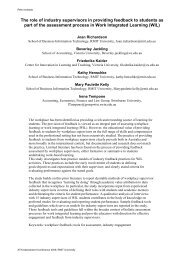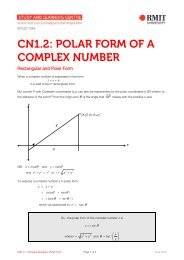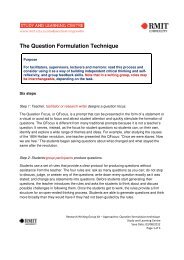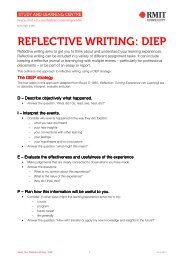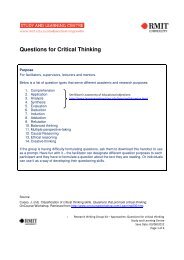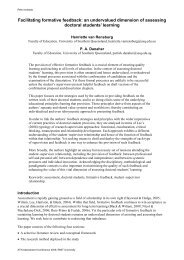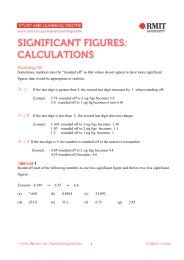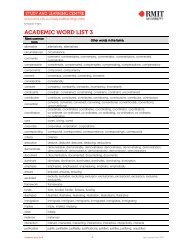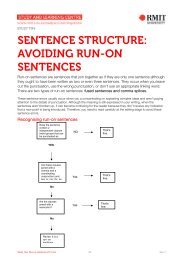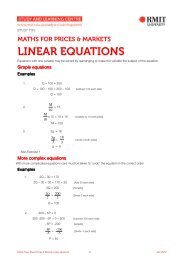Oral presentations (PDF 82.7KB)
Oral presentations (PDF 82.7KB)
Oral presentations (PDF 82.7KB)
Create successful ePaper yourself
Turn your PDF publications into a flip-book with our unique Google optimized e-Paper software.
ORAL PRESENTATIONS<br />
Many people say they are anxious about giving an oral presentation, but this nervousness<br />
can be dramatically reduced by knowing the material well. The best advice is to prepare<br />
carefully and allow plenty of time to practise.<br />
The process<br />
The following section outlines a useful approach to preparing a presentation.<br />
1. Analyse the task<br />
Analyse the question to be sure you understand what the topic requires. Will you be giving an outline of the<br />
topic or an in-depth analysis? Be sure that your topic has a clear focus.<br />
2. Brainstorm<br />
Bring all your ideas together on one page to take stock of what you already know. Identify gaps. Start a plan.<br />
3. Know your audience and venue<br />
What does your audience already know about the topic? It’s important to engage with everyone, not just your<br />
lecturer/teacher.<br />
Also, for assessment purposes, it’s important to show that you know the topic; therefore, key terms,<br />
procedures, concepts should be explained – even if you think the audience is familiar with them – so that the<br />
lecturer/teacher can see you understand them.<br />
Check out the venue if you haven’t been there before. Consider the size of the room and equipment available.<br />
4. Research and plan<br />
Use a variety of sources to bring in a range of ideas and information. The more informed you are on the topic,<br />
the more confident you will feel.<br />
Decide on a logical order for the points you want to make. Think about how they fit into the structure of your<br />
presentation (introduction, body, and conclusion).<br />
6. Write and edit<br />
Write notes to guide your talk. You shouldn’t try to script and read your presentation. Prepare your presentation<br />
slides and supporting visual materials. Edit them carefully for grammar and spelling.<br />
Make sure that any visual materials are clear and easily read by the audience: consider font type and size, use of<br />
colour. Diagrams and graphs may be useful to illustrate your points.<br />
7. Practise, practise, practise<br />
Practise out loud, either to friends or family or in front of the mirror. Practise using the main points and brief<br />
notes only. It is important that you know your topic thoroughly so that you don't read.<br />
Use introductory phrases for new points, and linking words to connect your ideas.<br />
Practise the volume of your speech and the speed at which you talk so that it fits the time allocated to the<br />
presentation.<br />
8. Deliver your presentation<br />
Your voice should be natural, expressive and easily heard.<br />
Use effective body language – posture, gestures, eye contact. Appear confident.<br />
Keep your audience interested by asking questions and directing their attention to interesting points on your<br />
slides.<br />
Expect your audience to ask questions, and try to predict and prepare for these questions.<br />
Study Tips: <strong>Oral</strong> <strong>presentations</strong> 1 April 2012
The structure<br />
Your presentation should have three distinct sections:<br />
• the introduction: an outline of the presentation<br />
• the body: presenting the new information<br />
• the conclusion: the answer.<br />
The structure is usually:<br />
Introduction<br />
Tell them what you’re going to tell them<br />
Body<br />
Tell them<br />
Conclusion<br />
Tell them what you just told them<br />
Introduction – an overview for the audience<br />
• Begin with a brief general statement outlining your presentation. You may need to define key terms.<br />
• Explain how you have structured the information and issues you will discuss.<br />
• Lead to a thesis statement, which summarises the presentation.<br />
Body – made up of logically connected ideas<br />
• Information is presented in sections around central ideas, consisting of main points and supporting<br />
details. These are similar to paragraphs in an essay but generally, written as dot points on your slides.<br />
• Be sure to relate your information directly back to the topic.<br />
• The sections need to be linked to create logical flow of information for your audience, for example:<br />
− First, I’d like to highlight the importance of …<br />
− Another important consideration is …<br />
− As you can see on the slide, X is also a major aspect of …<br />
Conclusion<br />
• Provides a very brief summary of the main points.<br />
• May open out with recommendations or predictions connecting your ideas back to the world again.<br />
• It can be appropriate to thank the audience for their attention to make it clear that you have finished.<br />
Note: The formal conclusion may be followed by questions from the audience.<br />
Study Tips: <strong>Oral</strong> <strong>presentations</strong> 2 April 2012



